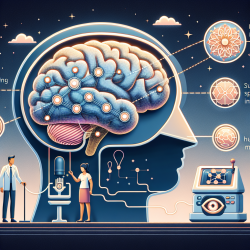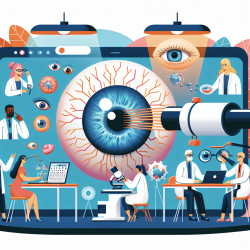Introduction
In the ever-evolving field of speech-language pathology, practitioners are constantly seeking innovative methods to enhance therapeutic outcomes for individuals with communication disorders. One groundbreaking study, "Machine learning-based multimodal prediction of language outcomes in chronic aphasia" by Kristinsson et al., offers a novel approach by integrating machine learning with multimodal neuroimaging to predict language outcomes in chronic aphasia. This blog explores how these findings can be implemented to improve clinical practice and encourages further research in this promising area.
The Study: A Brief Overview
The research by Kristinsson et al. involved 116 individuals with chronic left-hemisphere stroke, utilizing a combination of neuroimaging modalities such as functional magnetic resonance imaging (fMRI), diffusion-based fractional anisotropy (FA), cerebral blood flow (CBF), and lesion-load data. The Western Aphasia Battery was employed to assess aphasia severity and specific language functions. The study constructed support vector regression (SVR) models to predict language measures based on individual and combined neuroimaging modalities.
Key Findings
The study revealed that the multimodal prediction model significantly outperformed single modality models, achieving statistical superiority in 28 out of 30 model comparisons. The multimodal approach yielded the most accurate predictions, with correlation ranges between predicted and empirical data from 0.53 to 0.67. These results underscore the complementary advantage of integrating various neuroimaging modalities to provide a comprehensive depiction of brain damage and remaining brain functionality.
Implications for Practice
For practitioners, these findings highlight the potential of utilizing advanced data-driven approaches to enhance therapy outcomes for individuals with chronic aphasia. Here are some practical steps to consider:
- Embrace Multimodal Approaches: Incorporate multiple neuroimaging modalities in your assessment protocols to gain a more holistic understanding of a patient's brain function and structure.
- Leverage Machine Learning: Consider collaborating with data scientists to apply machine learning models in predicting language outcomes, thereby tailoring interventions more effectively.
- Continuously Update Skills: Stay informed about advancements in neuroimaging and machine learning to enhance your clinical practice and provide cutting-edge care.
Encouraging Further Research
While this study provides a robust framework for predicting language outcomes in chronic aphasia, it also opens the door for further research. Future studies could explore the integration of additional modalities, such as electroencephalography (EEG), to enhance prediction accuracy. Moreover, longitudinal studies could examine the long-term impact of multimodal assessments on therapy outcomes.
Conclusion
The integration of machine learning and multimodal neuroimaging represents a significant leap forward in predicting language outcomes for individuals with chronic aphasia. By embracing these data-driven approaches, practitioners can enhance therapeutic outcomes and contribute to the growing body of research in this field.
To read the original research paper, please follow this link: Machine learning-based multimodal prediction of language outcomes in chronic aphasia.










